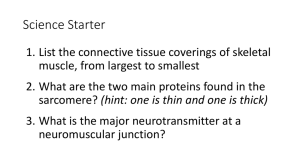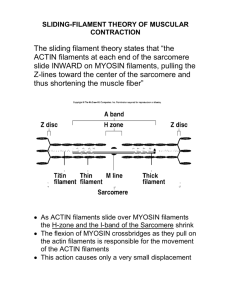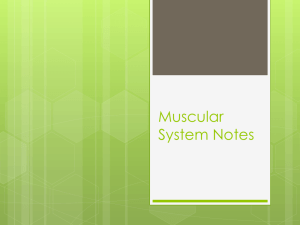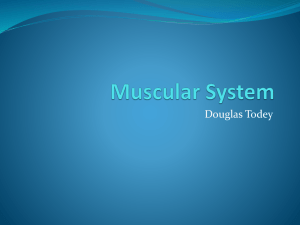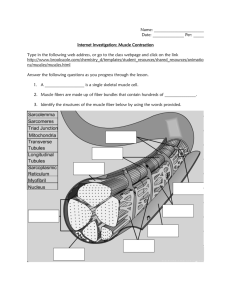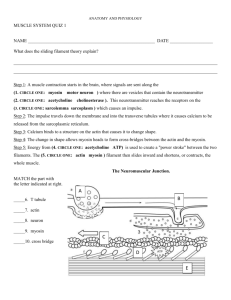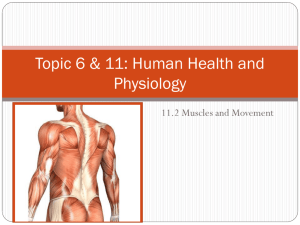Skeletal Muscle Contraction
advertisement
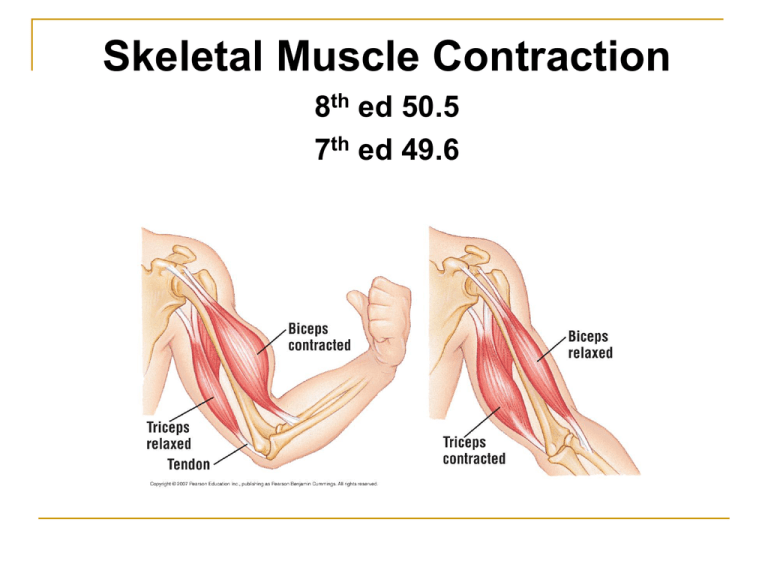
Skeletal Muscle Contraction 8th ed 50.5 7th ed 49.6 In order to move all animals require muscle activity in response to nervous system input. Skeletal muscles responsible for voluntary movement. Biceps contracts Skeletal muscles are attached to bones by tendons and are responsible for their movement. Forearm flexes Triceps relaxes Tendons Biceps relaxes Forearm extends Triceps contracts Organization of skeletal muscles: Have a hierarchy of smaller and smaller units Bundles of long fibers running parallel to the length of the muscle Each fiber is made of longitudinally arranged myofibrils Muscle Bundle of muscle fibers Single muscle fiber (cell) Nuclei Plasma membrane Myofibril Light Z line band Dark band Sarcomere Muscle Myofibrils are composed of thin and thick filaments Thin filaments are made of two strands of regulatory proteins and two stands of actin Bundle of muscle fibers Single muscle fiber (cell) Nuclei Plasma membrane Myofibril Light Z line band Dark band Sarcomere Thick filaments are made of staggered myosin molecules TEM I band A band M line 0.5 µm I band Thick filaments (myosin) Thin filaments (actin) Z line H zone Sarcomere Z line Skeletal muscles are striated – arrangement of filaments create dark and light bands 0.5 µm Z Skeletal muscle tissue under a light microscope H A Sarcomere I Skeletal muscle tissue under a electron microscope Sarcomere – repeating contractile unit of a muscle Thin filaments are attached at the Z line and proceed to the center of the sarcomere Thick filaments are attached at the M line in the center of the sarcomere Area near edge of sarcomere with only thin filament is the I band Region corresponding to the length of the thick filament is the A band Center of A band containing only thick filaments is called the H zone At a relaxed state thin and thick filaments partially overlap This overlapping arrangement is key to the contraction mechanism This regular arrangement produces dark and light bands and hence make the fibers look striated Sarcomere TEM I band A band M line 0.5 µm I band Thick filaments (myosin) Thin filaments (actin) Z line H zone Sarcomere Z line LE 49-29 Sliding-Filament model of muscle contraction (focus on a single sarcomere) During contractions the thin and thick filaments do not change in length but increase the overlap. 0.5 µm Z H A Sarcomere Relaxed muscle fiber Contracting muscle fiber This shortens the length of the sarcomere Fully contracted muscle fiber I Myosin molecule (thick filament) has a globular “head” and a long “tail”. Tail adheres to other tails. Thin filaments are actin molecules along with regulatory proteins Thick filament Thin filaments Thin filament Myosin head Thick filament Steps in muscle contraction: Myosin head is bound to ATP in a low-energy configuration Thick filament Thin filaments Thin filament Myosin head (low-energy configuration) Thick filament ATP is hydrolyzed to ADP and Pi and the head is now in high-energy configuration Thick filament Thin filaments Thin filament Myosin head (low-energy configuration) Thick filament Actin Cross-bridge binding site Myosin head (highenergy configuration) Thick filament Thin filaments Thin filament Head binds with actin filament at the myosin binding sites; forms cross bridge Myosin head (low-energy configuration) Thick filament Actin Cross-bridge binding site Myosin head (highenergy configuration) Cross-bridge Thick filament Thin filaments Head releases the ADP and Pi and returns to low-energy configuration; Actin (thin) filament moves towards the center of the sarcomere Thin filament Myosin head (low-energy configuration) Thick filament Thin filament moves toward center of sacomere. Actin Myosin head (lowenergy configuration) Cross-bridge binding site Myosin head (highenergy configuration) Cross-bridge Myosin binds to new ATP molecule and resumes the cycle Thick filament Thin filaments Thin filament Myosin head (low-energy configuration) Thick filament Nerves conduct signals by changing the voltage on the membranes (action potential) Sensory neuron: nerve cell that receives information from the internal or external environments and transmits the signal to the central nervous system (brain and spinal cord) Motor neuron: transmits signals from brain or spinal cord to muscles or glands. Synapse: junction where one neuron communicates with another neuron or with muscle/gland etc. Synaptic terminal: A bulb at the end of the axon in which neurotransmitter molecules are stored and released. Synaptic cleft: narrow gap separating synaptic knob of a transmitting neuron or its effector cell. Synaptic terminal of motor neuron Synaptic cleft Spinal cord Motor unit 1 Motor unit: A single neuron and all the muscle fibers it controls When motor neuron produces action potential all the muscle fibers in its motor unit contract as a group. Motor unit 2 Synaptic terminals Nerve Motor neuron cell body Motor neuron axon Muscle Muscle fibers Tendon Regulation of skeletal muscle contraction: Synaptic terminal receives action potential and releases neurotransmitter Acetylcholine (ACh) ACh binds to receptors in the muscle and triggers action potential in the muscle fiber. Action potential is propagated along the plasma membrane and down the T-tubule. Synaptic terminal of motor neuron Synaptic cleft ACh T TUBULE PLASMA MEMBRANE Synaptic terminal of motor neuron Synaptic cleft T TUBULE SR ACh Action potential triggers Ca2+ release from sarcoplasmic reticulum PLASMA MEMBRANE Ca2+ CYTOSOL Ca2+ Myosin cross-bridges attach and detach, powered by ATP pulling the actin filament towards center of the sarcomere When action potential ends Ca2+ is absorbed back into the sarcoplasmic reticulum Muscle contraction ends, muscle fibers relax CYTOSOL Ca2+ Synaptic terminal of motor neuron Synaptic cleft PLASMA MEMBRANE T TUBULE SR ACh Ca2+ CYTOSOL Ca2+ Motor neuron axon Mitochondrion Synaptic terminal T tubule Ca2+ released from sarcoplasmic reticulum Sarcoplasmic reticulum Myofibril Plasma membrane of muscle fiber Sarcomere Ca+ and regulatory proteins and their role in muscle fiber contraction Actin filaments have regulatory proteins on them. Tropomyosin, trponin complex and Ca2+ regulate muscle contraction At rest tropomyosin covers the actin binding sites preventing actin and myosin from interacting Tropomyosin Ca2+-binding sites Actin Myosin-binding sites blocked. Troponin complex When Ca2+ is released into the cytosol from the sarcoplasmic reticulum it binds to troponin complex. This changes the alignment of the troponin That in turn shifts the position of the tropomyosin, exposing the myosin binding sites on the actin filament When Ca2+ concentration drops the binding sites are covered and contraction stops. Ca2+ Myosinbinding site Myosin-binding sites exposed. Tropomyosin Ca2+-binding sites Actin Troponin complex Myosin-binding sites blocked. Ca2+ Myosinbinding site Myosin-binding sites exposed.
